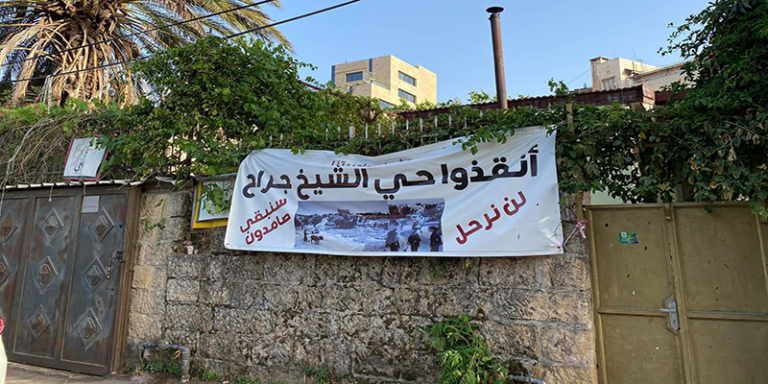
Protracted political conflicts are unpredictable phenomena. They tend to develop an internal momentum while awaiting their own uncertain future, often confusing both academic analysts and political decisionmakers. The Palestine issue is such a case. Over the past 73 years, the unresolved conflict between Israel and the Palestinians has often led to periodic unforeseen eruptions, usually caused by seemingly minor issues or events. Suddenly, they assume a larger-than-life dimension and a central relevance to the dispute by rallying its aggrieved parties, reigniting the dormant conflict, attracting international attention, and leading to a new escalation in the original or historic clash between the main adversaries. That is precisely what the current Israeli eviction order of Palestinian residents in the Sheikh Jarrah neighborhood of East Jerusalem has done.
The issue is not new at all. As Sarah Wildman wrote in The New Yorker more than eight years ago, “Sheikh Jarrah is one of the most contested strips of ground in a city that doesn’t lack for controversy.” The nondescript neighborhood of some “fifty-odd homes set on more-dirt-than-concrete streets, festooned with spray paint, and overrun,” according to Wildman, suddenly became a global cause célèbre, a microcosm of the overall Palestinian agony of dispossession and dispersion. As Reuters reported on May 11, 2021, Israel’s heavy-handed attempt to evict eight Palestinian families and replace them with Jewish settlers has led to violent clashes and “made Sheikh Jarrah an emblem of what Palestinians see as an Israeli campaign to force them out of East Jerusalem” and continue its Judaization of the city.
What Makes Sheikh Jarrah Unique?
Since its inception in 1948 as a settler colonialist regime, Israel has been engaged in the perpetual dispossession of the Palestinian people. The occupation in June 1967 of Gaza and the West Bank, including East Jerusalem, followed the same pattern by adding another category of refugees deprived of their homes and properties, awaiting a far-fetched and unlikely return home that never materialized: a uniquely Palestinian version of the tragicomedy, Waiting for Godot. The daily abuse by a brutal occupying power coupled with endemic political neglect by the international community, and further compounded by the failure of Palestinian authorities to rectify this injustice, led to frequent spontaneous public outbursts and uprisings throughout the past seven decades. In addition, it spurred several instances where seemingly routine incidents or developments evolved into emblems of the prolonged Palestinian agony. According to Seth Frantzman writing for The Jewish Chronicle, “Sheikh Jarrah is, in essence, another Khan al-Ahmar or Susiya or Al-Araqib,” referring to other cases of long-standing disputes over Palestinian land. It is a primal scream by an aggrieved population for an end to their incessant agony and misery.
At the same time, the ordeal of Sheikh Jarrah is unique for various reasons. First and foremost is the issue of timing which plays a significant part in determining the magnitude, duration, and impact of what started as a routine public outburst. Although Israel’s Sheikh Jarrah evictions of Palestinian families have been in process for many years, the latest confrontations occurred at a time when Israeli politics were moving dramatically to the right, allowing the pro-settler lobby in Israel to effectively assume a partnership role in the current governing coalition—with the possibility of an even larger and more decisive role in the next right-wing government being negotiated at this time. Practically speaking, this rendered Israel’s settlement policies significantly more aggressive and forceful in confiscating additional Palestinian land and depriving more Palestinians of their long-held family residences, like the families of Sheikh Jarrah, despite the visibility of their case. Therefore, aggressive practices and rhetoric on the Israeli side clearly contributed to a stronger expression of resistance on the Palestinian side. According to what could be dubbed as “Newton’s third law of politics,” to every action there is an equal and opposite reaction, equal in magnitude and opposite in direction.
Aggressive practices and rhetoric on the Israeli side clearly contributed to a stronger expression of resistance on the Palestinian side.
Second is the continuing governance crisis in Palestine, where after 27 years of existence, the Palestinian National Authority (PA) has failed dismally in effecting meaningful change in the quality of life in Palestine. It has also failed to bring its constituents even one iota closer to freedom and actual independence from perpetual Israeli military occupation that impacts all aspects of daily life in the West Bank and the besieged Gaza Strip. The recent inability of the PA to conduct a widely popular parliamentary election for the first time in 15 years undoubtedly deepened public frustration, particularly in East Jerusalem and its suburbs, where a process of economic and social ghettoization has been unfolding due to Israel’s creeping annexation in addition to PA neglect, whether purposeful or not. That frustration fueled the intensity of anger associated with the Sheikh Jarrah intifada.
The Sheikh Jarrah case has a unifying impact on Palestinians. Simply put, it quickly captured the imagination of most Palestinians regardless of their geographic or sociopolitical divisions.
The third unique component of the Sheikh Jarrah case is its unifying impact on Palestinians. Simply put, it quickly captured the imagination of most Palestinians regardless of the geographic or sociopolitical divisions separating them and mobilized them in an unprecedented manner that surprised friend and foe alike. What has been deemed a local Jerusalemite cause for more than 53 years, since the 1967 war, suddenly became a spontaneous national outcry for the over 13 million Palestinians worldwide. For example, despite the political differences between the Fatah-dominated government in Ramallah and its Hamas-controlled rival in Gaza, the events in East Jerusalem quickly spilled over from the West Bank and led to the ominous, ongoing military clashes between Palestinian forces in the Gaza Strip and Israel, displaying an intensity not witnessed since the 2014 war between the two parties.
Finally, there is the surprising impact of events in Sheikh Jarrah on the Palestinians inside Israel. These are citizens of the State of Israel who were still adjusting to the results of the March 23rd legislative election, broadly deemed as the most racist in Israeli electoral history. The violent attempts by the Israeli government to deal with the political problems in East Jerusalem clearly antagonized the already-agitated Arab population in Israel who sympathized with their fellow Palestinians facing confiscation of their homes and lands in the Sheikh Jarrah neighborhood. Scattered demonstrations in Israeli towns and villages were anticipated in solidarity with fellow Palestinians as witnessed many times in the past; however, the magnitude and intensity of the reaction this time surprised all observers. No one anticipated spontaneous mass protests with Palestinian flags to spread like wildfire from Jerusalem to Umm al-Fahm, Haifa, Acre, Nazareth, Ramla, Lydda, and other cities. It is quite significant to see Netanyahu declare a state of emergency and a nighttime curfew in Lydda, hometown to Israel’s Ben Gurion International Airport. Such a declaration had never happened before the game-changing Sheikh Jarrah intifada.

